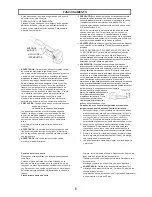
7
BASIC CUTTING PROCEDURE
See Figures 1-2
Keep the tree between you and the chain while limbing.
Cut from side of tree opposite branch you are cutting.
Do not cut from a ladder; this is extremely dangerous.
Leave this operation for professionals.
Do not use the pole saw for felling or bucking.
To prevent electrocution, do not operate within 50 ft. of
overhead electrical lines.
Follow the steps below to prevent damage to tree or shrub
bark. Do not use a back-and-forth sawing motion.
Do not make the flush cut next to the main limb or trunk until
you have cut off the limb further out to reduce the weight.
Following proper cutting procedures will prevent stripping the
bark from the main member.
Make a shallow first cut (1/4 of limb diameter) on the
underside of the limb close to the main limb or trunk.
Make a second cut from the top side of the limb outboard
from the first cut. Continue the cut through the limb until the
limb separates from the tree. Be prepared to balance the
weight of the tool when the limb falls.
Make a final cut close to the trunk.
For second and final cuts (from top of limb or branch), hold
front cutting guide against the limb being cut. This will help
steady the limb and make it easier to cut. Allow the chain to
cut for you; exert only light downward pressure. If you force
the cut, damage to the bar, chain, or motor can result.
Release the trigger as soon as the cut is completed. Failure
to follow proper cutting procedures will result in the bar and
chain binding and becoming pinched or trapped in the limb.
If this should happen:
Stop the motor and remove the battery pack.
If the limb can be reached from the ground, lift the limb while
holding the saw. This should release the “PINCH” and free
the saw.
If the saw is still trapped, call a professional for assistance.
LIMBING AND PRUNING
See Figures 3-4
This unit is designed for trimming small branches and limbs
up to 6 inches in diameter.
For best results observe the following precautions.
Plan the cut carefully. Be aware of the direction in which the
branch will fall.
Branches may fall in unexpected directions. Do not stand
directly under the branch being cut.
The most typical cutting application is to position the unit at
an angle of 60° or less, depending on the specific situation,
as shown. As the angle of the pole saw shaft to ground in-
creases, the difficulty of making the first cut (from the under-
side of the limb) increases.
Remove long branches in several stages.
OPERATING INSTRUCTIONS
ADJUSTING TELESCOPIC POLE
See Figure 5
Remove the battery pack from the pole saw.
Rotate the collar counterclockwise to loosen.
Push poles towards each other to shorten the pole or pull away from
each to lengthen the pole.
Note: Extend the pole only to the length required to reach the limb to
be cut. Do not extend the handle above waist height.
When the desired length is achieved, rotate the collar clockwise to
secure.
Note: Adjust hand placement on the shaft of the pole saw to keep
proper balance.
Do not attempt to use the pole saw at a length which does not allow
you to maintain proper footing and balance at all times.








































